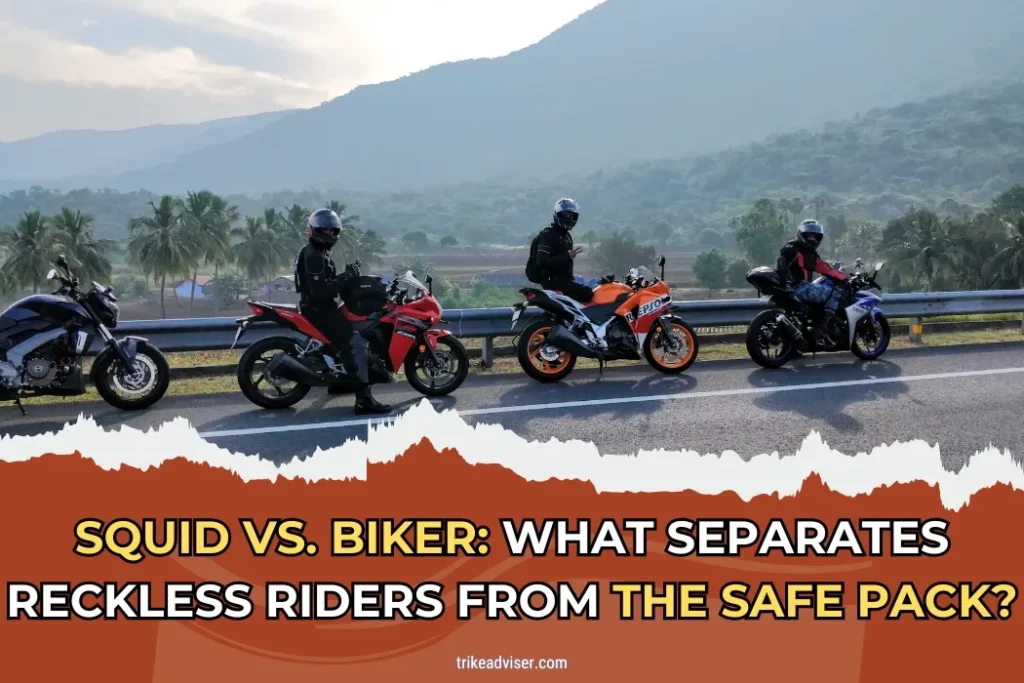You see them weaving through traffic, fearless, perhaps a touch foolish. Riders often split into two camps. The “Squids” — usually younger, thrill-seeking, usually on sports bikes, minimal gear.
And then, the “Bikers” — experienced, geared up, riding with respect for the rules. Why do some riders push the envelope, while others stick to the safer side?
It’s not just about attitude; it’s about choices and consequences. Do you value thrill over safety? Are you prepared for the risks of aggressive riding?
Choosing your camp isn’t trivial. It impacts everything from your insurance rates to your lifespan. Which rider are you? Think about it before you rev up your next ride.
Squid vs. Biker: What Separates Reckless Riders from the Safe Pack?
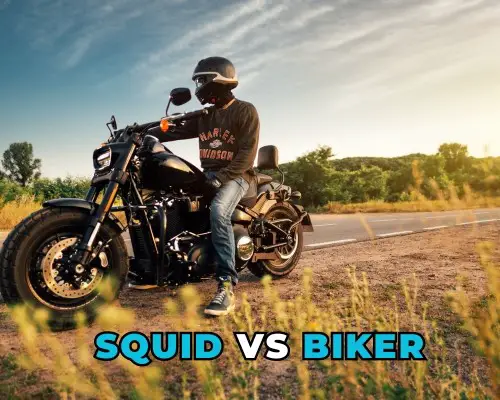
Squid vs. Biker: Understanding the Differences
Who Are the Squids?
Squids in the motorcycle world are often young, and enthusiastic but inexperienced. They overestimate their abilities, leading to risky behaviors.
Their bikes are loud in both sound and color, a mirror to their approach on the road. They weave through traffic, often giving little thought to the consequences.
Who Are the Bikers?
In contrast, bikers have years under their belt. They prioritize safety and control, treating riding as a skill to be honed over a lifetime.
Their approach is about enjoying the ride safely and respecting both the road and those who share it with them.
Key Practices to Distinguish Yourself from Squids
Balance and Control
It sounds simple, doesn’t it? Just keep the bike upright. But true control is about knowing how to manage your bike at all speeds.
Squids miss the mark here, prioritizing speed over safety. Proper training can make a massive difference. Statistics show that riders who undergo professional training are significantly less likely to be involved in accidents.
Smooth Riding
Smoothness isn’t just about comfort; it’s about predictability, which is crucial for safety. Jerky motions can unsettle the bike, leading to loss of control.
By mastering gentle throttle and brake use, bikers keep both wheels firmly on the ground and their ride predictable and safe.
Know Your Limits
Every rider’s journey begins with humility. Overconfidence leads many squids to push beyond their skills, which can result in accidents.
Bikers understand their current abilities and aim to expand them slowly, through continuous learning and practice. Remember, even professional racers never stop training and learning.
Wear Appropriate Gear
Imagine crashing without a helmet or proper gear. The scene isn’t pretty. Squids often gamble with their safety, wearing minimal protective gear.
On the other hand, bikers see gear as essential. According to the CDC, the use of motorcycle helmets reduces the risk of head injuries by 69% and deaths by 42%.
Respect for Road and Other Users
This isn’t just about following laws; it’s about shared respect. Squids often flout traffic rules, seeing them as obstacles to fun.
Bikers, however, understand that these rules are in place for the safety of everyone on the road. They maintain a keen awareness of their surroundings, ensuring they and the drivers around them are safe.
Legal and Ethical Considerations for Motorcycle Riders

Understanding Traffic Laws
Navigating the rules of the road sounds straightforward, right? Yet, many riders find themselves bending these guidelines, often with costly consequences. Here’s a deeper dive into the key laws every motorcyclist should respect:
- Staying Within Your Lane
Much like the lines on a page, lane boundaries are there for a reason. Crossing them can lead to more than just a scolding; it could result in a crash. - Stopping at Red Lights and Stop Signs
Ever noticed how stopping fully at a red feels like an eternity? However, failing to do so is not only illegal but dramatically increases the risk of accidents. - Yielding to Pedestrians and Other Cars When Turning
Yielding might seem like giving up your right of way, but it’s protecting it, ensuring everyone moves smoothly and safely. - Using Turn Signals When Changing Lanes or Merging
Think of turn signals as your way of saying “heads up, I’m moving over.” Without them, you’re just a surprise waiting to happen. - Following Traffic Laws
Speed limits and traffic signs are not suggestions; they are the difference between safe rides and dangerous chaos.
Consequences of Legal Infractions
Ignoring these laws might feel free at the moment, but the aftermath can be severe:
- Fines, Imprisonment, and License Suspension
Just like overpacking a bag only to break the scale, breaking traffic laws can weigh you down with fines, jail time, or even losing your license. - Liability Issues
If you’re injured because another driver broke the law, you could pursue damages. But remember, this is a two-way street.
Ethics on the Road
Moral obligations on the road extend beyond just following laws. They’re about fostering a culture of respect and safety.
- Respect for Other Road Users
Much like knowing how to pack a suitcase efficiently, riding respectfully means knowing how to share the road efficiently. - Defensive Riding
Think of defensive riding as looking both ways before you cross the street — it’s essential, no matter how quiet the road seems. - Visibility
Being visible on the road is like wearing a bright red shirt in a sea of grey — it ensures you stand out, keeping you safer.
How Ethical Riding Practices Enhance Community Safety
- Shared Responsibility
Safety on the roads is a shared responsibility, much like keeping a community garden thriving. Every driver and rider contributes to the overall health of traffic interactions. - Awareness and Caution
Just as you wouldn’t sprint across a busy intersection, drivers shouldn’t rush through areas frequented by motorcyclists. Awareness and caution can significantly reduce mishaps. - Defensive Riding
Adopting defensive riding is akin to having a good map; it prepares you for the unexpected and guides you safely through potential hazards.
Technical Skills and Training
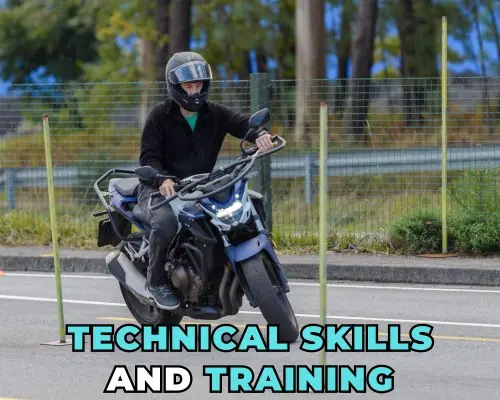
The Role of Professional Training
Professional training isn’t just about ticking boxes; it’s about building a foundation that will keep you upright on two wheels when it counts.
Remember when you first tried to pack light for a trip? It seems simple until you realize everything weighs more than you think.
- Importance of Technical Training
Just like learning to pack efficiently requires understanding each item’s weight and necessity, acquiring motorcycle skills through professional training is about understanding each skill’s impact on your riding. It’s about more than just staying upright; it’s about mastering control. - Types of Training
Diverse training avenues mirror the variety of gear available for a trek. You might start with formal classes, akin to reading a guidebook, then move to on-the-job training, similar to navigating a trail with a seasoned guide.
Online courses offer the flexibility to learn at your own pace, much like planning your route on a map.
- Benefits for Riders
The benefits are tangible. Imagine the confidence you feel with a well-packed bag, knowing you have exactly what you need.
Professional training offers the same confidence on the road, reducing accident rates by up to 30%, according to safety studies.
For organizations, this translates to lower insurance costs, fewer lost workdays, and a stronger safety culture.
Advanced Riding Techniques
Mastering advanced riding techniques is like adjusting your pack’s straps mid-hike for better balance and comfort. It’s about fine-tuning your skills to handle whatever the road throws at you.
- Key Techniques
Defensive riding, for instance, isn’t just about avoiding accidents; it’s about anticipating potential hazards before they arise, similar to spotting and avoiding obstacles on a path.
Advanced cornering can feel as nuanced as choosing the right path around a steep curve on a hike—both require precise judgment and control.
- Training Methods
Training that includes real-world scenarios acts as a simulation of challenging trails you’ve never walked.
Peer learning is like hiking with a group where each member shares insights about the path ahead, while gamification in training introduces elements of play, which can make learning complex maneuvers more engaging and memorable.
- Continuous Learning and Assessment
Just as hikers continuously adapt to changing trails and climates, motorcyclists benefit from ongoing practice and reassessment of their skills.
Regular skill assessments are akin to checking your gear before a major leg of a journey—necessary to ensure readiness and safety.
Adding depth to your motorcycle training is about integrating these elements into a continuous, engaging learning experience.
Just as no two trails are the same, no two rides are identical. Each ride offers new challenges and learning opportunities, emphasizing the need for thorough preparation and continuous improvement.
By investing in comprehensive training, you not only enhance your own riding experience but also contribute to a safer, more responsible riding community.
Understanding the Mindset – Thrill vs. Responsibility
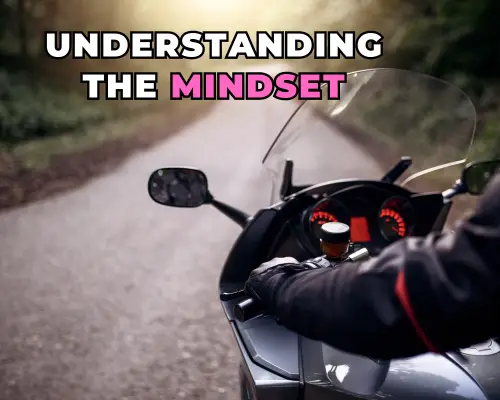
Thrill-Seeking Mindset
Envision preparing for an unexpected alpine hike beneath the stars. Many bikers are motivated by the excitement of spontaneity and the attraction of an impromptu adventure. They frequently push boundaries just to feel alive, loving the fast speeds and wind in their faces.
- Characteristics of Thrill-Seekers Thrill-seekers often ride as they pack for an unknown trail—light on precautions and heavy on adrenaline.
They’re drawn to motorcycles for the freedom they offer, the quick escape from the mundane. However, this can often lead to overlooking essential safety measures, like not wearing proper gear or ignoring speed limits.
- Consequences of a Thrill-Seeking Approach This approach can lead to dire outcomes. For instance, riders without helmets are three times more likely to suffer brain injuries in crashes than those who wear helmets.
The thrill can be intoxicating, but the fallout is real and measurable—increased risk of severe injuries or even death.
Responsibility Mindset
Compare this to carefully packing for a long-distance trek, where each item is selected based on its need and utility.
This way of thinking views riding a motorbike as a duty to both other drivers and oneself, in addition to being a vehicle for enjoyment.
- Benefits of a Responsibility Mindset Riders who adopt this mindset enjoy their journeys more profoundly. They understand that with great power comes great responsibility—managing it wisely leads to longer, more satisfying riding careers.
This deep satisfaction comes from knowing they are skilled, prepared, and respectful of the road and its rules.
- Steps to Cultivate a Responsibility Mindset Transitioning to a responsibility mindset is like adjusting your load after the first mile of a hike—it makes the rest of the journey more enjoyable and sustainable:
- Recognize the Benefits: Awareness of the safety statistics can be a sobering but motivating factor.
For instance, responsible riding reduces the likelihood of accidents by over 40%, much like how the right gear can prevent mishaps on a trek.
- Take Ownership of Actions: It’s about looking back at the end of a ride and asking, “How could I have made that safer?”
This reflection is crucial for growth and improvement, akin to revisiting a trail map after a hike to see where you might have gone off the path.
- Set Achievable Goals: Just as a hiker sets out milestones along their route, a rider should aim for continuous skill enhancement—be it through advanced courses or regular practice sessions. Each goal achieved builds not only skill but also confidence.
- Seek Support: Engage with communities that prioritize safety. Experienced riders often have insights that can reshape how you think about and approach riding, much like seasoned hikers share tips that transform how you pack or navigate.
Balancing Thrill and Responsibility
Integrating thrill with responsibility is the art of packing both essential safety gear and a few comforts that enhance the experience.
It’s possible to enjoy the rush of speed and freedom within the bounds of safety and law, ensuring a fulfilling ride every time.
Riders who achieve this balance not only ensure their safety but also set a standard and inspire others in the community.
How Motorcyclists Can Avoid Being Reckless
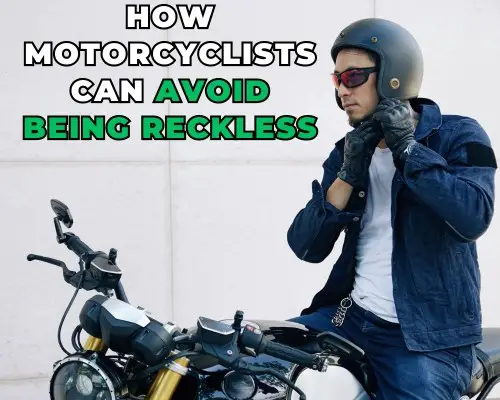
Recognize Your Environment
Riding a motorcycle demands that every sense be attuned and distractions be kept to a minimum, much like making sure every item in your backpack is necessary before a strenuous journey.
- Stay Alert and Attentive Similar to keeping your equipment dry, you may stay ready for fast decisions by clearing your head of distractions like loud music or cell phones.
Riding while preoccupied is just as risky as driving while intoxicated, with experts estimating that it increases the probability of an accident by almost 400%.
- Environmental Awareness Awareness is your lifeline on the road, much like a compass on a hike.
It involves more than scanning for immediate threats; it involves predicting possible changes in traffic patterns, understanding road signs, and even reading the body language of pedestrians and drivers. This proactive approach can decrease your risk of accidents significantly.
Keep a Safe Distance
On the trail, you wouldn’t walk too close to someone on uncertain footing, and the same applies to the road.
- Buffer Zone Keeping a buffer zone around your bike isn’t just about reaction time; it’s about having enough space to maneuver safely away from a sudden obstacle. Traffic studies suggest that maintaining a three-second gap from the vehicle in front can reduce collision chances by over 60%.
Avoid Speeding
Speed on a motorcycle can feel exhilarating, like the wind rushing past you on a downhill run, but it comes with high risks.
- Control Your Speed Keeping within speed limits is much like monitoring your pace on a challenging hike; too fast, and you risk exhaustion or injury, too slow, and you may not reach your destination timely.
On the road, appropriate speed keeps you in sync with the flow of traffic and allows adequate time for safe reactions to any sudden stops.
- Speed and Risk Statistics According to traffic reports, speeding is a factor in approximately one-third of all motorcycle accidents.
Reducing speed by 10 mph can dramatically decrease the energy impact in a crash, akin to wearing the right fall protection gear during climbing.
Avoid Tailgating
Like following too closely on a narrow mountain path, tailgating doesn’t leave you enough room to safely stop.
- Maintain Distance Always adjust your following distance based on speed, traffic density, and road conditions.
Remember, what seems like enough space at low speeds can become dangerously inadequate at higher speeds due to increased momentum.
Drive Defensively
Think of defensive driving as you would about wearing the right gear for unpredictable weather on a hike.
- Anticipate and React Always expect the unexpected, from sudden stops to abrupt lane changes by others. Keep a watchful eye on indicators of such moves, like brake lights and turn signals, or cars drifting towards lane edges.
- Defensive Riding Techniques Invest in advanced riding courses that focus on defensive driving. These courses often use simulations that prepare you for real-world scenarios, improving your reaction times and decision-making under stress.
Stay Calm and Alert
Just as you would not embark on a physically demanding activity without the right mental preparation, never ride if you are not mentally up to it.
- Avoid Impaired Driving Just as dehydration or an injury can end a hike prematurely, riding while impaired by alcohol, drugs, or fatigue can lead to disastrous consequences. Remember, your reaction time and judgment are your first lines of defense while riding.
- Mental Fitness Mental fitness is crucial. Stress or emotional turbulence can cloud judgment and delay reactions almost as severely as physical impairments.
Like checking the weather before a hike, assess your mental state before you ride. If you’re feeling off, consider other transport options.
As an Amazon Associate, I earn from qualifying purchases, at no additional cost to you. Read Our Affiliate Disclosure.

